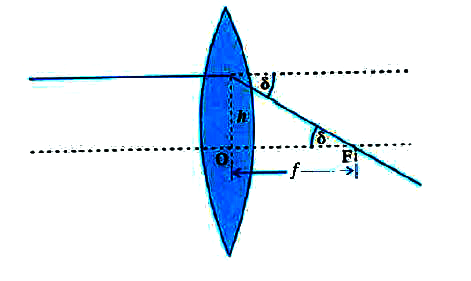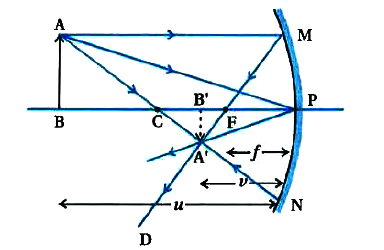Define power of lens, obtain its equation and write its SI unit. Solution in Gujrati
Power of a lens is a measure of the convergence or divergence, which a lens introduces in the light falling on it.
Clearly a lens of shorter focal length bends the incident light more, while converging it in case of a convex lens and diverging it in case of a concave lens.
The power P of a lens is defined as the tangent of the angle by which it converges or diverges a beam of light falling at unit distant from the optical centre.

From figure
tanδ=hf
If h=1 tanδ=1f
and for small value of δ tanδ=δ
∴δ=1f
∴ Power P=1f
The SI unit for power of a lens is dioptre (D)
∴1D=1m−1
The power of a lens of focal length of 1 metre is one dioptre.
Power of a lens is positive for a converging lens and negative for a diverging lens.
Thus, when an optician prescribes a corrective lens of power + 2.5 D, the required lens is a convex lens of focal length + 40 cm.
f=1P=12.5m
∴f=100025cm=+40 cm
A lens of power of – 4.0 D means a concave lens of focal length f = 1−4m = - 25 cm
By using lens maker.s formula,
P=1f=(n−1)(1R1−1R2) power of lens can be obtained.
Topper's Solved these Questions
- BOOK - KUMAR PRAKASHANCHAPTER - RAY OPTICS AND OPTICAL INSTRUMENTSEXERCISE - SECTION - A (TRY YOURSELF)74videos
RAY OPTICS AND OPTICAL INSTRUMENTS
- BOOK - KUMAR PRAKASHANCHAPTER - RAY OPTICS AND OPTICAL INSTRUMENTSEXERCISE - SECTION-B (NUMERICALS)(NUMERICAL FROM TEXTUAL ILLUSTRATIONS)17videos
RAY OPTICS AND OPTICAL INSTRUMENTS
- BOOK - KUMAR PRAKASHANCHAPTER - MOVING CHARGES AND MAGNETISMEXERCISE - SECTION D (MCQs ASKED IN COMPETITIVE EXAMS)34videos
MOVING CHARGES AND MAGNETISM
- BOOK - KUMAR PRAKASHANCHAPTER - SAMPLE QUESTION PAPER EXERCISE - PART-B SECTION-C5videos
SAMPLE QUESTION PAPER
Similar Questions
Give range of wavelength of visible light.
01:09View SolutionSuppose that the lower half of the concave mirror.s reflecting surface as shown in figure is covered with an opaque (non-reflective) material. What effect will this have on the image of an object placed in front of the mirror ?
 03:26View Solution
03:26View SolutionElectric charge Q having mass M moves on a circular path of radius R with velocity →v, perpendicular to uniform magnetic field B. When a particle completes one revolution, work done by the field is _______
03:37View SolutionTwo charges –q and +q are located at points (0, 0, –a) and (0, 0, a), respectively.
(a) What is the electrostatic potential at the points (0, 0, z) and (x, y, 0) ?
(b) Obtain the dependence of potential on the distance r of a point from the origin when r/a>>1 .
(c) How much work is done in moving a small test charge from the point (5,0,0) to (–7,0,0) along the x-axis? Does the answer change if the path of the test charge between the same points is not along the x-axis?02:04View SolutionDefine power of a lens and write its unit
View Solutionलेंस की क्षमता को परिभाषित कीजिए तथा इसका SI मात्रक लिखिए।
03:44View SolutionDefine power of a lens. Give its S.I unit?
02:19View SolutionDefine power of a convex lens. What is its unit?
03:10View SolutionDefine power of a lens and write its SI unit.
View SolutionDefine power of a lens and write its unit
05:43View SolutionDefine power and its SI unit.?
03:09View SolutionWhat is meant by power of a lens? Define its SI unit.
01:28View SolutionDefine power of lens. What is its unit?
01:07View SolutionDefine electric power. What is its Si unit?
View SolutionDefine power of a lens. Write its S.I. unit
01:42View Solution

